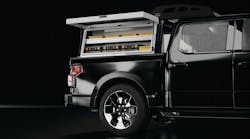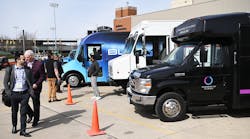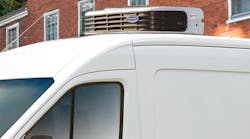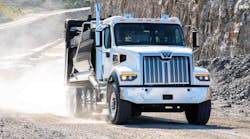WHO are you?
It used to be so easy, according to Darry W Stuart of the DWS Fleet Management Services Group, but now it's a delicate balancing act between overcharging a customer and giving great customer service.
“How do you maximize your profit margin and stay in business?” he asked. “There are different repair service traits in the service business: fleet service repairs, parts, retail work. There's no particular magic. There's no one road to where you're going to go. The fleets that are out there are looking for any type of unique things — something different that fits into their world.”
Stuart said services desired by fleets include:
- Accelerated services.
- Quick-lane type of speed.
- Quick diagnosis.
- Quick, accurate customer contact.
- Quick quote for a vehicle needing repair.
- No chain of delay.
- No repair delay.
- Night service.
- Weekend service.
- Fleet on-site service.
Repair and maintenance opportunities include:
- ABS systems.
- Diesel Particulate Filter (DPF) programs.
- Air conditioning parts and on-site service programs. “In the last four or five years, the most valuable service is AC mobile repair,” he said.
- Electrical expertise programs.
- Engine diagnostic programs.
- On-site services.
- Transmissions diagnostics.
- Preventive Maintenance Services (PM). “Most fleets do not have a good PM program, so if you can develop and design one for the customer, that's something you can sell.”
- Fleet driver vehicle inspection report (DVIR) services. “Respond to DVIRs with repairs on site, check as required, repair as required, bill for time and material, be fair on the charger, provide vehicle uptime, and act and think as a fleet — not as a service provider. There are opportunities at this end of the business.”
He said the following things will not disappear in the shop of the future:
- Inspection services.
- Brake services.
- Axle-repair services.
- Safety inspections.
- CSA inspection repairs. “Everybody is scrambling. Fleets quite honestly don't know how to manage those writeups. I have client that is a $21 billion company with 6000 reefer trailers, and 50% are serviced by outside people. That's 3000 trailers in seven locations. They have no intention of opening up a garage or going for Capex money to build buildings. Why? They don't know how to manage it.”
- Lights repairs.
- Battery services. “We're still very naïve on the fleet side on how to manage batteries.”
- Electrical services.
- Tires, wheels and exhaust.
- Alignment services. “Most fleets don't do alignments. It's a huge opportunity.”
- Tire and wheel maintenance. “It exists today and will exist tomorrow.”
- DPF service. “This is kind of a scary thing because I'm not sure we know where we're at with this. When the industry started with this, we were going to be able to exchange DPF filters. It hasn't sorted itself out yet. We don't know how many miles we'll get between servicing. But we do know that when something goes wrong upstream — a coolant leak or fuel leak — it's going to destroy the DPF.”
- Trailer repairs. “This will never go away, and I see it getting much better.”
- Inventory management services. “They still don't know how to manage this end of the business.”
- Fleet filter management.”
He said the shop of the future must have an accessible management office with a clean workplace environment.
“They have to look like supermarkets,” he said. “They have to be clean. They have to be organized. You are as you are perceived. When a customer comes in and looks at your operation, and it's dirty and nasty, you may not recognize that he recognizes it.
“There have to be productive work stations. Safety is critical. OSHA is going all over the place, just looking to fund itself.
“Tool storage is critical. You have to think that your cost is $1 a minute. You have to make sure when your technician goes in to find tool that you're charging $80 to $100 an hour for labor, he's not wasting any time finding that tool.
“You have to run your parts department like a supermarket: clean floors, clean shelves, organized.”
He said technicians will need: driving skills, with a CDL a must; tire awareness and repair skills; AC and brake certification; cutting and welding skills (“It's amazing how few have these); electrical skills and ABS knowledge; people, internal, external, phone, and customer skills; and computer skills and diagnostic processes.
He said technicians need to be treated properly after they're hired. That means attractive benefits and pay. It means desirable hours and schedules, with holidays off equal to the office staff, weekends off, overtime (a reasonable amount and steady, not only when the company needs), clean-looking uniforms, shift pay ($1 to $5 for shift compensation) and an above-average hourly rate.
“If the average is $24, and you're having a hard time finding employees, try $28,” he said. “The profit is not going to come from the outside. It's going to come from the inside — efficiencies on the inside.”
In terms of technology, Stuart compliance for shops for natural-gas vehicles will include: training for all employees; firewalls possibly required for partial repair bays; no open flames in heaters, so they will have to be changed; exhaust fans of 10000 cfm; methane detection and monitoring devises (National Fire Protection Association Code 52 and Code 30, also tied to exhaust fans and electric door openers, with natural gas between 5% and 15% and a heat source of 1200 degrees F); and shop modification from 90 to 120 days under perfect plans of deployment.
“There is no simple process,” he said. “The dollars are expensive and variable from building to building, county to county and state to state. Seek local consultants. New shops are less expensive than retrofitting because of updated local codes. It starts and ends with the local fire chief. See him first.”
What needs to improve?
- Fees
“You have to establish credibility every single day, every single minute. There are too many fees. Just be careful how you charge them. Everything costs money, but be careful how you charge. Be careful of a flat rate. Make sure somebody's not smart enough on the fleet side to figure out you're charging 60 hours for 40 hours of work for on-site service. If you give good value, you can do that. Be consistent, be fair. Profits is not a dirty word.”
- Communication
“It has to be like you'd find at Cadillac, BMW, and Mercedes dealerships. That costs money, but that's what the industry is going for. Wherever you're taking your car, if you're happy with that level of service, that's the service you should be giving on your own.”
- Training
“They need it in management, customer service, mechanical, electrical, attitude, phone skills. They need ‘irate customer defusing’ training. Learn not to argue and remove dollars in decision consideration.”
- Be and act like a fleet
“Think like a fleet, manage maintenance like a fleet, respond like a fleet, jump like a fleet, manage assets like a fleet, listen like a fleet, profit like a service provider.”
Aftermarket Service: Change is Inevitable
Tom Kotenko, general manager Snap-on Business Solutions
Kotenko said that change and chaos in this market bring opportunity. Technology is changing every industry — take a look at what's happening to bookstores and travel agencies — and it will change the commercial vehicle repair market, which currently has 13,000 independent repair shops, 50,000 fleet maintenance facilities, and 3000 dealerships.
“The average age of a technician is 48-55,” he said. “We're trying to attract the younger person. What does the younger person relate to? The technology. They understand the integration of information and technology. That's where we have to get to in this business as a whole.
“Owners and fleet operators at one time dominated the truck service industry. Outsourced service is forecast to increase. The consistent increase in the need for tools, equipment and labor costs will raise maintenance costs. The number of smaller truck fleets (one to five trucks) is forecast to increase at a faster rate than the larger fleets (25 trucks or more). These smaller fleets likely do not have an on-site repair and maintenance facilities.”
Kotenko said truck manufacturers are aggressively looking at ways to expand their thinking about partnerships beyond traditional industry boundaries.
“The dilemma for truck manufacturers is that the brand of the vehicle is being commoditized, so truck manufacturers will have to evolve their definition of brand and develop solutions,” he said. “Telematics is the important investment for the future. Hybrid truck development is critical for the future, particularly given increased urbanization globally. The winners by 2020 will have significantly transformed their workforce.
“Truck manufacturers are transitioning from a brand image centered on the vehicle to one that addresses the larger transportation solution: navigation/routing and full-service contracts. Today, vehicles are sold with non-integrated add-ons. By 2020, the value will be in integrated solutions. The differentiation won't be on products, but on services.”
He said there is confusion in the aftermarket regarding diagnostic tools — PC-based versus scan tools, with 13-plus different applications and 13 different user interfaces. Different scan tool products are offering various functionalities. In addition, with OEMs supplying to large fleet customers, each has a different approach.
“In coping and adapting to significant change, smaller shops should become larger through a ‘network’ through working with ‘larger groups,’” he said. “The benefits include increased purchasing power and access to some OEM information.”
21st Century Training: Finding What Works
Dave Milne, president Automotive Training Managers Council (ATMC)
Milne said the challenge is finding quality training for heavy-duty technicians, which is critical to business success as technology advances.
Training resources currently available: NATEF-accredited secondary and post-secondary training schools; ATMC members; suppliers; tool, equipment, and parts manufacturers; independent training organizations; in-house training programs; and training events, trade shows, etc.
“Begin by evaluating your technical staff on training needs by identifying knowledge gaps,” he said. “Some good ways to do this include: ASE certification testing; assessment testing from a training provider; and input from managers/supervisors.
“Good training is based upon good science, and generally accepted practices.”
What are the elements you should look for to determine if a training program will be effective and to insure that you get a reasonable return on the money you invest? Program overview, subject, target audience, delivery method, projected class size (if appropriate), the expected results, and any innovations.
“The developers will have conducted an accurate needs analysis outlining why this training is necessary,” he said. “The training provider should clearly state the knowledge and skills that the trainees will learn as a result of this training. The provider should clearly list any materials or takeaways associated with the instruction. For example, PowerPoint slide reproductions, workbooks, job aids, online resources, etc.
“How is the training delivered? Instructor-led, hands-on, online, self-study? Is this method convenient and affordable for your trainees? What methods are used to quantify the results of the training against the intended outcome? Use follow-up discussions with attendees to verify successful training and share info with coworkers.”








